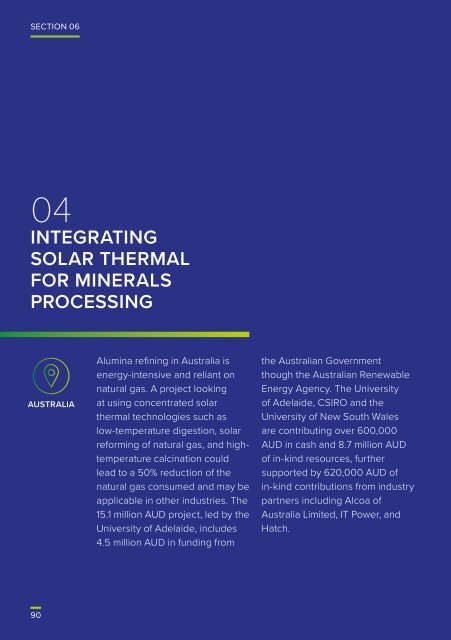MI 2020 Solutions FINAL
You also want an ePaper? Increase the reach of your titles
YUMPU automatically turns print PDFs into web optimized ePapers that Google loves.
SECTION 06<br />
SECTION 01 INDUSTRY | ENERGY<br />
04<br />
INTEGRATING<br />
SOLAR THERMAL<br />
FOR <strong>MI</strong>NERALS<br />
PROCESSING<br />
AUSTRALIA<br />
Alumina refining in Australia is<br />
energy-intensive and reliant on<br />
natural gas. A project looking<br />
at using concentrated solar<br />
thermal technologies such as<br />
low-temperature digestion, solar<br />
reforming of natural gas, and hightemperature<br />
calcination could<br />
lead to a 50% reduction of the<br />
natural gas consumed and may be<br />
applicable in other industries. The<br />
15.1 million AUD project, led by the<br />
University of Adelaide, includes<br />
4.5 million AUD in funding from<br />
the Australian Government<br />
though the Australian Renewable<br />
Energy Agency. The University<br />
of Adelaide, CSIRO and the<br />
University of New South Wales<br />
are contributing over 600,000<br />
AUD in cash and 8.7 million AUD<br />
of in-kind resources, further<br />
supported by 620,000 AUD of<br />
in-kind contributions from industry<br />
partners including Alcoa of<br />
Australia Limited, IT Power, and<br />
Hatch.<br />
05<br />
H2FUTURE<br />
Steel manufacturing is one of the<br />
largest sources of CO2 emissions.<br />
Cutting these is necessary to<br />
achieve the goals set at the<br />
United Nations Climate Change<br />
Conference (COP21) in 2015.<br />
The €18 million H2Future,<br />
a Fuel Cell and Hydrogen<br />
Joint Undertaking (FCH JU)<br />
project, is one of the first to<br />
explore harnessing the power<br />
of renewable hydrogen to<br />
decarbonise steelmaking. An<br />
innovative electrolysis pilot<br />
plant will be constructed at the<br />
Voestalpine production site,<br />
currently one of Austria’s biggest<br />
greenhouse gas emitters. One<br />
of the largest and most modern<br />
electrolysers using Proton<br />
Exchange Membrane technology<br />
will be deployed to produce<br />
green hydrogen for industrial<br />
use, which will be fed directly into<br />
Voestalpine’s internal gas network<br />
for testing in various process<br />
stages of steel production.<br />
The EU backed project where<br />
Voestalpine, Siemens and<br />
Austrian utility Verbund join<br />
forces, represents the type of<br />
unique public private cooperation<br />
that is needed to address the<br />
complexity of curbing industrial<br />
CO2 emissions. By supporting<br />
research, technological<br />
development and demonstration<br />
in fuel cell and hydrogen<br />
technologies, the FCH JU aims to<br />
accelerate market introduction in<br />
order to realise the technologies’<br />
full potential for achieving a<br />
carbon-lean energy system<br />
across multiple sectors.<br />
EC<br />
90<br />
91


